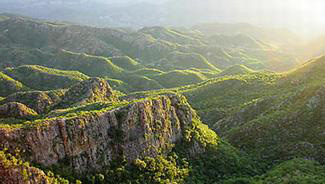
|
 |
 |
 Editorials | Environmental | February 2008 Editorials | Environmental | February 2008  
Mexican Ranches Transformed Into Endangered Jaguar Reserve
 Wildlife Extra Wildlife Extra
go to original


| | The 45,000 acre reserve, which provides a sanctuary for the world's northernmost breeding population of jaguars, is the centrepiece of a bi-national effort by the Northern Jaguar Project and Naturalia to safeguard and restore the jaguar in the U.S.-Mexico borderlands. | | |
Jaguars in northern Mexico have a newly protected habitat today due to the official establishment of the Northern Jaguar Reserve in the state of Sonora. The 45,000 acre reserve, which provides a sanctuary for the world's northernmost breeding population of jaguars, is the centrepiece of a bi-national effort by the Northern Jaguar Project and Naturalia to safeguard and restore the jaguar in the U.S.-Mexico borderlands.

‘This land is perfectly suited to support North America's largest wild cat,’ said Oscar Moctezuma, director of Naturalia, the Mexican conservation organization that will hold title to the property. ‘The Northern Jaguar Reserve is a dream come true for the many people who have worked hard for its establishment and, most importantly, for the endangered jaguar,’ said Moctezuma.

80-120 Jaguars

‘In this remote and rugged area of northern Sonora, a small population of 80 to 120 jaguar struggles to avoid extinction,’ said Diana Hadley, president of the Northern Jaguar Project based in Tucson.

With assistance from the Northern Jaguar Project, Naturalia purchased the 10,000 acre Rancho Los Pavos in 2003. Located in a region of abundant biodiversity, Los Pavos was the first ranch acquired to establish this jaguar reserve. Next, the Northern Jaguar Project spearheaded the purchase of the adjacent 35,000 acre Rancho Zetasora at a cost of $1.5 million with contributions from more than 600 individual donors and private foundations. The final payment for Zetasora was made at the end of January and completes the 70 square mile reserve.

‘The purchase of Zetasora is a crucial step in creating a reserve large enough to effectively protect jaguars as well as dozens of threatened and endangered species,’ said Hadley.

The Northern Jaguar Project

The Northern Jaguar Project has established a stewardship endowment fund to provide permanent support to guard the jaguar population, begin the process of ecological restoration, foster wildlife research, and continue educational and incentive programs with local ranchers to reduce poaching and to elevate conservation awareness.

Several area ranches are for sale, a result of the current drought and difficulty of ranching in this remote area. The partners plan to expand the reserve through purchase of ranches from willing sellers, and engage in educational programs and community outreach programs to encourage further local support for the project.

The Northern jaguar Reserve

The Northern Jaguar Reserve has the highest number of jaguar sightings in northern Mexico and is the only reserve where female jaguars have been protected.

‘With lengthy frontage on the Aros River, a single, often impassable road, and deep canyons with deer and other prey, the reserve supports the best possible habitat for northern jaguars,’ said Moctezuma.

‘The Northern Jaguar Reserve presents a once-in-a-lifetime opportunity to save this species,’ said Hadley. ‘Even if the border fence temporarily blocks jaguar migration, the reserve will help ensure a pathway for jaguars to again roam their former range in the southwestern United States.’

Largest Cat in North America – Not Worth Saving in the USA

The jaguar, Panthera onca, is the largest cat native to North America and the third largest cat in the world. In the U.S.-Mexico borderlands the American jaguar has been eliminated from its entire U.S. range except for a few individuals, all males.

Last month, the U.S. Fish and Wildlife Service announced that it will not prepare a recovery plan for the jaguar and will not attempt to recover the species in the United States or throughout its range in North and South America. | 
 | |
 |



